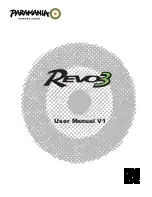
EN
17
16
Packing
• Spread the glider flat on its top surface, then lay the cleared lines on top. The risers should be laid on
the ground, at the centre of glider, near the trailing or leading edge.
• Take a wing tip and fold it in to the centre of the wing. Repeat this until the glider is folded up and
approx. 60 cm’s wide.
• Fold the glider so that the bundle is approximately the size and shape of the B*Lite rucksack. Never
roll the wing up as this introduces unnecessary stresses into the fabric.
• Always pack your XXLite 2 as loosely as you can, as every fold weakens the cloth on any paraglider.
Storage and Transport
Always store all your flying equipment in a dry room, protected from direct heat. Leave it as loosely packed
as practical.
Your wing should be dry before being packed away. Moisture, heat and humidity are the worst elements
for damaging your glider. Storing a damp glider in your car under the sun would be terrible for example.
If you land in salt water, you must first rinse it thoroughly with clean fresh water. Dry the wing completely,
preferably out of the sun, in the wind. Never use a hair dryer, etc.
Take care that no insects get packed away with the wing. They may eat the cloth and make holes in a bid
to escape. They can also leave acidic deposits if they die and decompose.
Transport the wing in the supplied bags and keep away from oils, paints, chemicals, detergents etc.
Cleaning
Any kind of wiping/scratching can damage the coating of the cloth. We recommend to not clean the wing,
but if you do have to, use a soft cloth dampened with a small amount of water and use gentle movements
little by little across the surface.
Wing Repairs
Always let a registered dealer, professional repair centre or the manufacturer carry out any major or
complex repairs, especially those near seam margins.
If you damage the sail:
If the rip is small and in the middle of a panel however you can fix it yourself. You’ll find all the materials
in the repair kit you need. The fabric can be simply mended with the sticky rip stop/spinnaker tape. When
cutting out the patches allow ample overlap of the tear and make sure both sides are different sizes. Make
sure to round off each corner of the patches. You can find more information about basic repairs on the
Ozone website, including step by step instructions with pictures.
If you damage a line:
Any line that is visually damaged MUST be replaced. Use a reputable paragliding service centre to make
the replacement lines. Alternatively you can order them from your local Ozone dealer or directly from our
website http://www.flyozone.com/paragliders/en/shop/lines.php It is important that replacement lines are
made from the correct materials and diameters. You should check lengths against their counterpart on
the other side of the wing to make ensure symmetry. Once the line has been replaced, inflate and check
the glider before flying.
Maintenance Checks
You alone are responsible for your flying kit and your safety depends on it. Take care of your equipment
and have it regularly inspected. Your wing should be serviced by a qualified professional for the first time
after 12 months, or after 80 hours. However, if the wing is flown regularly we recommend a more frequent
interval. The checker should inform you about the condition of your glider and if some parts will need to
be checked or changed before the next normal service check period. The sail and the lines do not age
in the same way or at the same rate; it is possible that you may have to change part or all of the lines
during the wing’s life. For this reason it is important to do regular inspections so that you know the exact
condition of all of the components of your glider. We recommend that inspections are carried out by a
qualified professional.
IMPORTANT
Never pack away or
store your glider wet.
IMPORTANT
Never use detergent or
chemical cleaners.
Содержание XXLite 2
Страница 1: ...Pilots Manual...
Страница 2: ......
Страница 16: ...1258 Route de Grasse Le Bar sur Loup 06620 France...




























